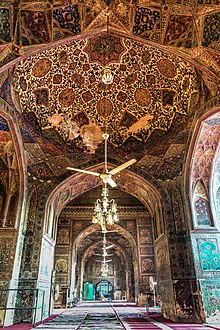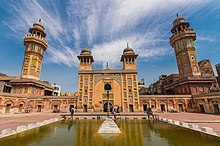Wazir Khan Mosque:
The Wazir Khan Mosque (Punjabi, Persian, Urdu: مسجد وزیر خان; Masjid Wazīr Khān) is a 17th-century mosque located in the city of Lahore, Punjab, Pakistan. The mosque was commissioned during the reign of the Mughal Emperor Shah Jahan as a part of an ensemble of buildings that also included the nearby Shahi Hammam baths. Construction of Wazir Khan Mosque began in 1634 C.E., and was completed in 1641.[1] It is on the UNESCO World Heritage Tentative List.[2]
Considered to be the most ornately decorated Mughal-era mosque,[3] Wazir Khan Mosque is renowned for its intricate faience tile work known as kashi-kari, as well as its interior surfaces that are almost entirely embellished with elaborate Mughal-era frescoes. The mosque has been under extensive restoration since 2009 under the direction of the Aga Khan Trust for Culture and the Government of Punjab,[4] with contributions from the governments of Germany, Norway, and the United States.[5]
Architecture

The mosque is built on an elevated plinth, with the main portal opening onto the Wazir Khan Chowk. The outer perimeter of the Wazir Khan Mosque measures 279 feet (85 m) by 159 feet (48 m), with the long axis parallel to the Shahi Guzargah.[20] It was built with bricks laid in kankar lime.[20]
Decorative elements
Wazir Khan mosque is renowned for its elaborate embellishment in a style which draws from the decorative traditions from several regions. While other monuments in Lahore from the Shah Jahan period feature intricate kashi-kari tile work, none match the enormous scale of the Wazir Khan Mosque.[21]
Structure
Bricks facing the mosque's exterior are richly embellished with the Persian-style title work known as kashi-kari.[10] Façades facing the inner courtyard are richly embellished with motifs and palette which display strong influences from 17th century Persia.[citation needed] Persian-style colours used include lajvard (cobalt blue), firozi (cerulean), white, green, orange, yellow and purple,[22] while Persian-influenced motifs include star-shaped flowers and grapevines.[citation needed] The mosque also contains motifs of cypress trees, and is the first Mughal monument to have borrowed this motif from Persia.[citation needed]

The façade of the entry portal facing Wazir Khan Chowk is decorated with elaborate tile work and calligraphy that includes verses of the Quran, the sayings of the Prophet Muhammad, prayers for the Prophet, and calligraphic insignias.[19] Above the iwan entrance to the main prayer hall are verses from the Quran's surah Al-Baqara written by the calligraphist Haji Yousaf Kashmiri.[19]
Conservation
The mosque complex is listed on the Protected Heritage Monuments of the Archaeology Department of Punjab.[31] In 1993 the site was added to UNESCO's tentative list for World Heritage Site status.[32] In 2004, the Government of Punjab embarked on conservations and restoration efforts for the mosque.[33] In 2007, the Aga Khan Trust for Culture partnered with the Government of Punjab to restore the monument, and in 2009 began a two year long in-depth survey of the mosque as part of a larger effort to restore the Walled City of Lahore.[34] In 2015, the site was mapped in 3D through a partnership between the Lahore University of Management Sciences and the United States Agency for International Development.[35]
Restoration
Restoration works at Wazir Khan Mosque began in 2004.[36]
In 2012, the Pilot Urban Conservation and Infrastructure Improvement Project—the Shahi Guzargah Project was launched by the Government of Punjab and the Aga Khan Trust for culture which restored a section of Shahi Guzargah between the mosque and Delhi Gate.[33] The project was completed in 2015 with support from the governments of Norway and the United States of America.[37]
Prior to completion of the project's first phase, the vicinity around the Wazir Khan mosque had been encroached upon by illegally erected shops which blocked off much of the mosque from the surrounding neighbourhood. Tangled power lines further spoiled views of the mosque, and the Wazir Khan Chowk had been badly neglected and had shrunk in size due to illegally constructed shops. The first phase of the project removed illegally constructed shops, restoring views of the mosque. Wazir Khan Chowk was extensively rehabilitated by removal of encroachments, while the well of Dina Nath was restored. Power lines along the project corridor were also placed underground, and the Chitta Gate at the eastern entrance to Wazir Khan Chowk was rehabilitated.[38]
References
- ^ "Conservation of the Wazir Khan Mosque Lahore: Preliminary Report on Condition and Risk Assessment" (PDF). Aga Khan Development Network. 2012. Retrieved 25 August 2016.
The Wazir Khan Mosque was built in 1634-35 AD (1044-45 AH), by Hakim 'Ali ud din* a governor of Punjab in the early part of the reign of the Mughal emperor Shah Jahan.
- ^ "Badshahi Mosque, Lahore". UNESCO World Heritage Centre. UNESCO. Retrieved 7 May 2020.
- ^ Masson, Vadim Mikhaĭlovich (2003). History of Civilizations of Central Asia: Development in contrast : from the sixteenth to the mid-nineteenth century. UNESCO. ISBN 9789231038761
Hakim Ilmud Din:
The mosque depicted here was built in 1634 by Hakim Ilmud Din, popularly known as Wazir Khan and Viceroy of Punjab during the reign of the Mughal Emperor Shah Jahan. This period is characterised by great architectural innovations in Lahore, generated by the prosperity of the Mughal Empire.








0 Comments